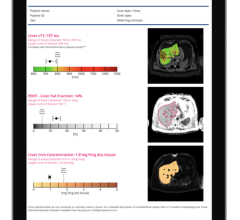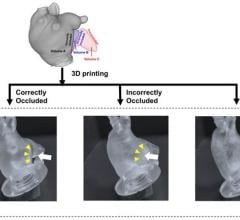
February 28, 2017 — Magnetom Vida, the new high-end 3 Tesla magnetic resonance imaging (MRI) scanner with BioMatrix technology from Siemens Healthineers, was launched to the public at University Hospital Tübingen, Germany, where the first system is installed. It has been undergoing clinical tests in the hospital’s Department for Diagnostic and Interventional Radiology since December 2016.
Magnetom Vida will be presented at the European Congress of Radiology (ECR) in Vienna, Austria, from March 2 to 5.
Due to high levels of exam variability, MRI is often considered to be one of the most complex medical imaging modalities. Physiological and anatomical differences between patients, as well as different experiences levels in users, contribute to this unwanted variability. This frequently is a source of errors, rescans and inefficient workflows in MR imaging. Siemens Healthineers addresses precisely this issue with its new BioMatrix technology.
BioMatrix Sensors in the table automatically track a patient’s respiratory pattern, giving users insights into a patient’s individual ability to hold his or her breath during the scan. This allows the user to select the optimal exam strategy, while also saving time during the examination. BioMatrix Tuners can help avoid rescans, which represent a major burden on productivity as well as a driver of additional costs in radiology. In cervical spine examinations, for example, this feature uses intelligent coil technology to automatically set the optimal scan parameters based on the individual patient anatomy, all without any additional user interaction. BioMatrix Tuners also improve the quality and reproducibility of whole-body diffusion. Precise control of scan parameters in real-time to match the individual patient anatomy makes it possible to avoid distortions, which can render diffusion imaging non-diagnostic, especially in 3 Tesla MRI. Innovative interfaces also help ensure a consistently high examination quality, accelerating workflows and improving quality of care. BioMatrix Interfaces accelerate the scanning process by up to 30 percent. Automated patient positioning based on intelligent body models automatically moves the patient table to the correct scan position. An intuitive touchscreen user interface integrated onto the scanner allows for one-touch positioning. A new, easy-to-move motorized patient table further simplifies examinations, especially for adipose, immobile and trauma patients.
Prof. Konstantin Nikolaou, medical director of the Department of Diagnostic and Interventional Radiology at University Hospital Tübingen, considers Magnetom Vida to be part of the general trend toward precision medicine: “To provide our patients with individual therapies, we need every piece of information available. When it comes to imaging, this means that we need robust, standardized and reproducible image data that are always of the same quality regardless of the patient or user. Only then we can compare results and link them with additional information, such as data from laboratory medicine or genetics,” said Nikolaou, referring to the clinical validation of the new MRI scanner in his department. “Magnetom Vida gives us this data quality and comprehensive image information so that we can choose the right kind of personalized therapy and evaluate it – to see, for instance, how a patient responds to chemotherapy before tumor removal. This MRI scanner along with BioMatrix technology is the perfect fit for our current medical approaches, and is helping us on our way to quantitative radiology,” said Nikolaou.
“We can examine sick patients faster with Magnetom Vida,” said Prof. Mike Notohamiprodjo, who, as head of MRI at University Hospital Tübingen, works intensively with the new scanner. “The scanner offers the highest degree of patient comfort with the performance of a research system, which speeds up our workflows,” he said. As examinations in Tübingen show, the new scanner decreases measurement times for musculoskeletal and prostate imaging compared to previous MRI systems, and it does so with significantly improved image quality, according to the hospital. “The signal-to-noise ratio in the clinical images is up to 30 percent higher than with systems from the previous generation,” said Notohamiprodjo3.
Magnetom Vida’s all-new system architecture offers extremely high performance and long-term stability without requiring any more space than previous clinical systems. The new scanner’s 60/200 XT gradient system provides over 2.7 megawatts of power, making it the most powerful commercially available gradients in a 70-centimeter bore scanner, according to Siemens. And, thanks to a very large field of view (55x55x50 cm), Magnetom Vida can also cover larger body regions in one step, such as full coverage abdominal exams.
The result is a great increase in productivity for routine examinations of the brain, spine, and joints – from correct patient positioning at the touch of a button to transferring the clinical images to the picture archiving and communication system (PACS). This is made possible by the GO technologies, which automate and simplify workflows from the start of the scan right through to the quality control of the image data. A new user interface allows not only for automated acquisition and processing, but also more advanced post-processing applications to run at the scanner. With spine examinations, for instance, GO technologies reduce the time needed by about a fifth. This means that a department could carry out four additional spine examinations per day and per system. Given the decline in reimbursement rates, this is of great value to many radiological institutes, according to Siemens.
The system also allows customers to access additional clinical growth fields – for instance, by serving patient groups that were previously deemed unsuitable for MRI due to issues such as cardiac arrhythmias, excess weight or health problems that prevent them from actively supporting the scan. Magnetom Vida also expands Siemens Healthineers’ Compressed Sensing applications – which can make MRI scans up to 10 times faster – to cover more body regions. It features Compressed Sensing Cardiac Cine, which allows free-breathing cardiology examinations, even when using contrast medium for comprehensive tissue characterization. Now, Compressed Sensing Grasp-Vibe, which enables dynamic, free-breathing liver examinations in one comprehensive scan by the push of button and for every patient, is also available. Dynamic liver imaging traditionally required four steps, with breath-holds and complex timing. Grasp-Vibe technology also makes the post-processing of liver images significantly faster. During the studies he carried out in Tübingen, Notohamiprodjo found that post-processing times fell from 20 to just 4 minutes.
Magnetom Vida even simplifies whole-body scans, which are currently particularly challenging because they have to cover multiple scan sections and demand highly trained users. A new technology, the Whole-Body Dot Engine, allows these difficult scans to be carried out in predictable time slots, as short as 25 minutes, with very high quality. This is accomplished through intelligent automation. The planning and execution of the scan requires only a few simple clicks. Combined also with its strong 60/200 gradients and a large homogeneous field of view, the system makes whole-body examinations simple to perform, reproducibly and with very high quality. This is a major advantage, particularly when treating oncology patients, such as those with multiple myeloma, a type of bone marrow cancer, where guidelines have recently been moving toward whole-body MRI scans for therapy control.
Magnetom Vida offers not only numerous clinical advances, but also a number of improvements in energy consumption. These help to lower the total cost of ownership of the system over its entire life cycle. Technologies such as Eco-Power provide an intelligent control of power-hungry components by switching them off when they are not needed for longer periods of time. The result is an MR scanner that consumes 30 percent less energy than the industry average for 3 Tesla scanners, as reported by the European Coordination Committee of the radiological, electromedical, and healthcare IT industry (COCIR).
Magnetom Vida is pending U.S. Food and Drug Administration (FDA) 510(k) clearance.
For more information: www.siemens.com/healthineers


 October 31, 2025
October 31, 2025 








